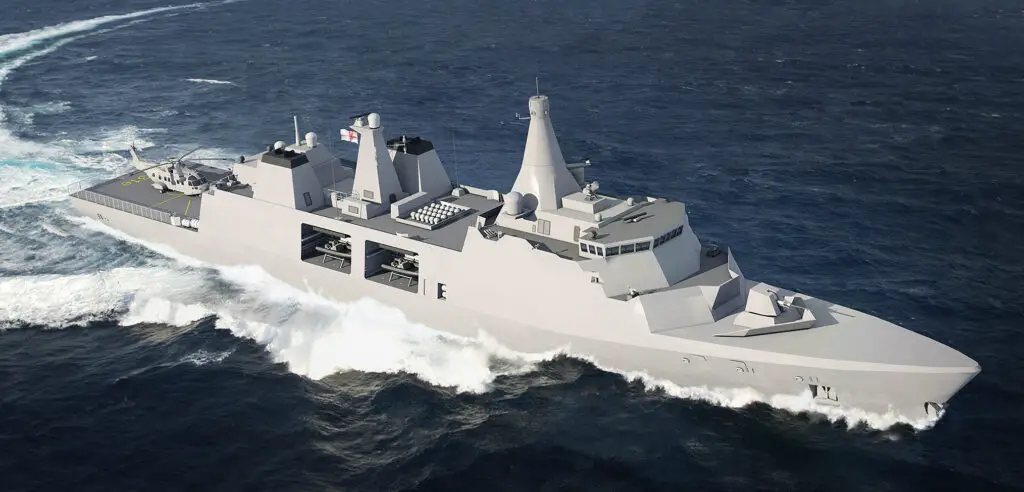Warsaw has ordered three Arrowhead 140 frigates (AH140) from the British company Babcock International under the Miecznik Class program. The construction of frigates will take place in Poland by the Polish consortium PGZ SW (Polska Grupa Zbrojeniowa) and Remontowa Holding. Construction of the first frigate will begin in 2023 at the Polish shipyards PGZ Stocznia Wojenna SA and Remontowa Shipbuilding S.A. Thales. Thales U.K. and MBDA UK are involved in the construction of the frigates.
The British design bagged the contract amid stiff competition from the Spanish Navantia frigate F110 (Bonifaz Class), the German Thyssen-Krupp – Lürssen F125 and Blohm + Voss shipyard MEKO A-200. The construction of three Miecznik class frigates, including a logistics package and armaments, may exceed ten billion zlotys, making it the largest one-time arms contract in the history of the Polish arms industry. However, Warsaw chose the cheapest solution. Navantia had offered the F110 frigate with the U.S. combat system AEGIS, which was the first to be rejected due to the high price.
In the Polish Navy, the frigates will replace two older ex-American corvettes of the Oliver Hazard Perry class. Later, Poland may opt to replace the Kaszub corvette (Project 620) with the Miecznik Class. Three new frigates, along with the recently introduced Slazak corvette, will form the backbone of the Polish Navy.
Miecznik class vessels are to be networked with Polish F-35A Lightning II aircraft and Patriot batteries.
Miecznik is a long-term military-industrial program. The goal is to introduce new frigates into the Navy and provide the Polish shipbuilding industry with entirely new competencies in constructing battleships. The first frigate Miecznik will enter service in 2028, and the others in 2033 and 2034.
The AH140 class frigates
The AH140 class frigates are based on the Danish Iver Huitfeldt class frigates. The Royal Navy also chose the AH140 platform to build five Type 31 frigates (Inspiration class). London will induct five vessels by 2030. The Indonesian Navy recently ordered two AH140s.
The AH140 measures 139 meters in length and has a displacement of 5,700 tons. With the four Rolls Royce diesel engines with an output of 4 × 8.2 MW, the vessel will develop up to 26 knots. Four electric generators with four × 900 kW will power the ship’s electrical and electronic systems.
Poland will work on the final configuration of armaments and equipment of the Polish Miecznik frigates throughout this year. In any case, Babcock International has already published a visualization of a possible form of the Polish AH140. Miecznik’s design can accommodate eight Kongsberg NSM anti-ship missiles and one RIM-116 RAM short-range missile defense missile system.
The proposal also envisages the installation of a 76 mm Leonardo 76/62 Sovraponte automatic naval cannon, the Polish anti-aircraft system OSU-35 calibre 35 mm, and 324 mm torpedo launchers and helicopter Sikorsky MH-60R.

Combat systems include Thales U.K. integrated TACTICOS fire command and control system connected to the NS110 3D radar. The system is onboard more than 160 ships (from small patrol vessels to destroyers) in 25 navies. TACTICOS can also be found on the Polish Slazak corvette and Polish Orkan class rocket boats.
The key air defense armament will become sea Ceptor anti-aircraft and anti-missile missiles from MBDA UK. The main task of Polish frigates will be to control the airspace over the Baltic Sea. The frigates are meant to prevent Russian air operations and prevent the Russians from using the Baltic Sea area for aeromobile helicopter operations.
Sea Ceptor is launched from vertical shafts to hit targets in the range of 360 ° and at a distance of 25 kilometres. The projectile is ejected from the shaft using a pneumatic mechanism. The missile has its active radar and destroys aircraft and guided missiles. In total, the AH140 can hold up to 32 vertical shafts for various types of rockets.
The Polish frigate debate
The construction of frigates in Poland is causing great controversy. The supporters of the frigate say that the frigate can fight for local air domination over the Baltic Sea, protect the Polish coast maritime logistics routes and prevent Russian aircraft operations over the Baltic.
The critics say the frigates are “big, bold and enticing” targets, vulnerable to Russian coastal missile systems. According to critics, such large sums of money should not be invested in frigates but the ground and air systems.
The shipyards have to adapt the frigates to the peculiarities of the Baltic Sea. One of the extremes of the Baltic is its extremely shallow depth. Although the Baltic Sea meets all the sea’s features, it is an atypical sea. It is a flooded land area, left by a receding ice sheet. For a long time, it was an ordinary lake.
Rationale of three frigates
The Miecznik frigates will primarily protect the Polish coast and support the NATO Alliance’s maritime operations. At the same time, the frigates will protect the trade of goods and energy raw materials between the Polish conglomerations Swinoujscie and Tricity with the rest of the world. Poland’s entire energy security is dependent on the transport of energy raw materials through Polish ports in the Baltic Sea.
At the same time, the frigates will become an effective coercive tool against Russia. As per Polish strategy Strategiczna Koncepcja Bezpieczeństwa Morskiego RP, three frigates will be able to gain “local control” over the Baltic Sea.
